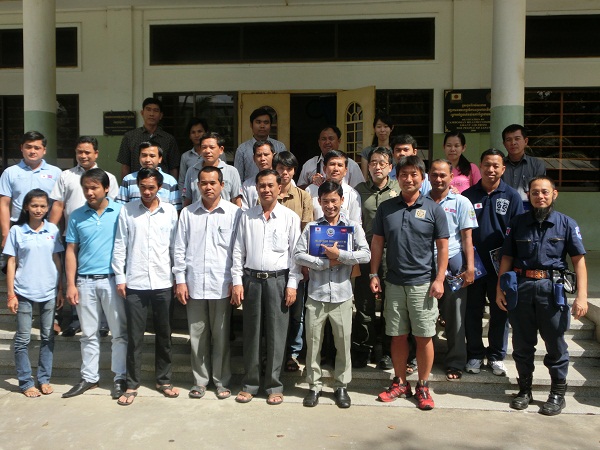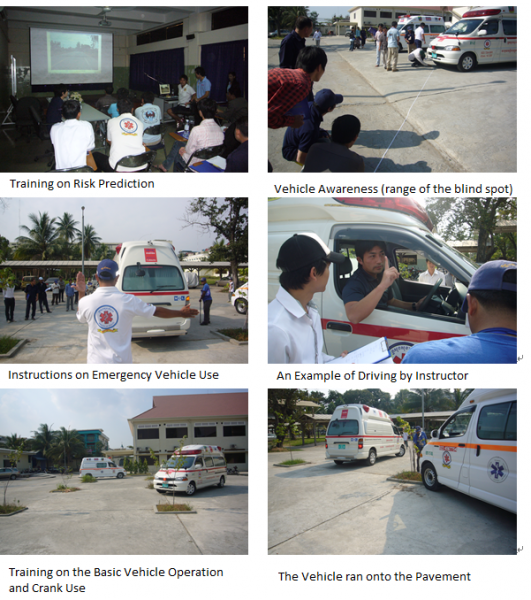Project Outline
Due to the increase in traffic accidents and natural disasters in recent years in Cambodia, infrastructure development related to pre-hospital emergency medical care is urgently needed. At the request of the Cambodian government, SPF conducted a one-year project in FY2011 entitled 'Consolidating the Cambodian emergency support system'. In light of their positive assessment of SPF's project, the Cambodian government approached SPF once again with a request to begin a project for development of human resources in the prehospital care system.
In this project, as a means to facilitate the organization of prehospital care in Cambodia, SPF will contribute to the Cambodian government's activities in line with its policy of building life-saving infrastructure. Specifically, the Foundation aims to train health care workers and personnel involved in emergency rescue and transportation. To this end, workshops on emergency rescue and vehicle/equipment maintenance will be provided for emergency workers active in the fields of rescuing the injured from scenes of traffic accidents and disasters as well as those involved in actually transporting the injured to hospitals.
Project Content
●1st Workshop Held
From September 3 to 13, 2012, the first workshop of the 'Prehospital Care System Development in Cambodia' project was held at the Khmer - Soviet Friendship Hospital in the capital of Cambodia, Phnom Penh. Two individuals with extensive experience and knowledge in the field (Mr. Yuki Nakayama, lecturer, Department of Sport and Medical Science, Faculty of Physical Education, Kokushikan University; Mr. Hitoshi Igarashi, consultant) were dispatched from Japan to act as lecturers at the workshop.
This first workshop was held with the objective of providing emergency medical technicians (EMT) with experience in emergency rescue with the knowledge and fundamental techniques necessary for activity as a paramedic. Thirty-three people took part in the workshop, including not only staff from state hospitals in Phnom Penh, Sihanoukville, and Kampong Cham, but also medical personnel from the Cambodian military.
For a number of years in Cambodia, training has been carried out to improve the capabilities of emergency personnel with assistance from overseas organizations. However, with the number of traffic accidents so high in Cambodia in recent years that the situation has come to be referred to as the 'traffic wars', there has never been a greater need for rapid rescue and transport to take injured parties to safety. Thus, the objective of this first workshop was to offer a single 'rescue and emergency transport' package aimed at raising the ability of emergency personnel to carry out such tasks.
The curriculum for the workshop was based on a set of standard programs used in Japan for emergency work, modified for the situation in Cambodia. Among other topics, the participants studied ethical (understanding the importance of being alive and irreplaceability of life), fundamental facts about anatomy and physiology including body mechanisms (body regions, body cavities, directional etc.), and the mechanism of injury, as well as comprehensive transport skills including stretcher bearing, radio communication techniques, communication in times of emergency, mass casualty incident (MCI) and triage, simulation exercises including traffic accidents and falling accidents, in addition to topics in emergency medicine and sections of Cambodian law relevant to emergency rescue work.

Workshop venue (Khmer-Soviet Friendship Hospital in Phnom Penh)
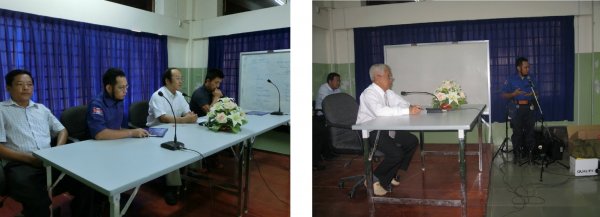
Opening ceremony to welcome the Secretary of the Ministry of Health

The lecture
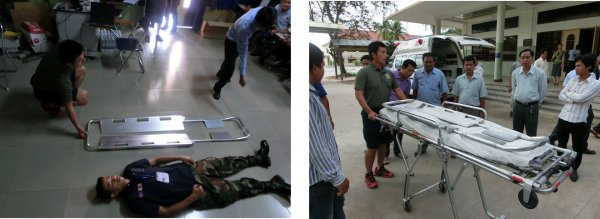
The scoop stretcher

Patient transportation

Cardiopulmonary resuscitation (CPR)

A rescue in progress

Rescuing a victim trapped under a vehicle

Proficiency testing (written, practical)
●2nd Workshop Held
*Outline
From December 3 to 14, 2012, the second series of workshops aimed at raising the capacity of young future leaders in the field of emergency medicine in Cambodia and developing the emergency transport system from the bottom up was held at the Khmer - Soviet Friendship Hospital in Phnom Penh.
The participants of the workshop were doctors and nurses who had attended the first workshop in September and already studied the fundamentals of emergency medicine. The workshop was split into two groups, based on individual abilities. The first group, comprising 17 participants, took part in a foundation course focusing on practical skills in the field, while the second group, with 10 participants, took part in an advanced course focusing on improving medical skills.
As was the case with the first workshop, Mr. Yuki Nakayama, lecturer in Department of Sport and Medical Science, Faculty of Physical Education, Kokushikan University, and Mr. Hitoshi Igarashi, consultant, provided instruction for the trainees.
*Course for practical abilities in the field (Foundation Level)
The trainees taking part in this foundation level course were emergency rescue personnel who were already affiliated to a rescue team at a rural hospital but who lacked the experience of such personnel in Phnom Penh due to the lower number of call outs in rural areas. Also taking part were rescue personnel needing to develop their core skills in the field.
In this course, reminder classes were provided on the concept of pre-hospital care. In Cambodia at present there is still a lack of understanding regarding pre-hospital care, thus the trainees were provided with opportunities to study its importance and the responsibilities that rescue teams have in this area. After this refresher course, the 17 participants were split into three groups and placed at three hospitals: Khmer - Soviet Friendship Hospital, Calmette Hospital, and Phnom Penh Municipal Referral Hospital. The groups rotated between all three hospitals, studying the activities of the rescue teams at each location.
The trainees studied proper usage of ambulances and rescue equipment, and were provided with guidance in emergency call outs by the Japanese specialists. By taking part in all aspects of an emergency call out, from the initial request for assistance to provision of first aid at the scene, the trainees were able to learn about the entire process of emergency care in Phnom Penh city. For the trainees from rural areas, it was their first experience of the 119 emergency system employing interpreters, and they were able to absorb a great deal of new information and knowledge. Though the trainees from rural areas will require much more study and training in the future, this course did provide them with a solid understanding of the concept of pre-hospital care.
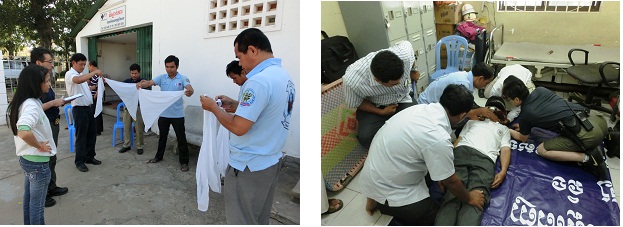
Use of a triangular bandage (left) Training in dealing with motorbike accidents (right)
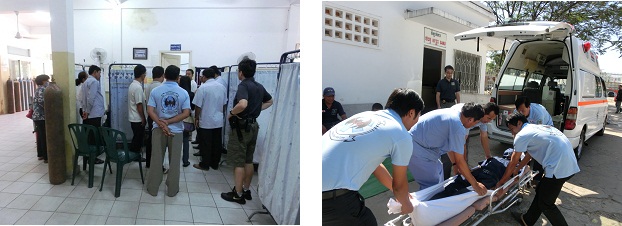
Phnom Penh Hospital (left) Khmer - Soviet Friendship Hospital (right)
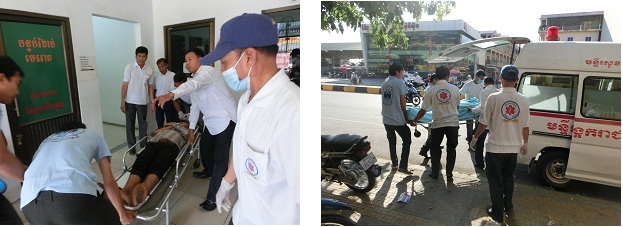
Patient transport (left and right: Emergency call out via a 119 call)
*Course in teaching young students (Advanced Level)
In the advanced course, the trainees studied basic skills of CPR, haemostatic techniques, fracture fixation, childbirth assistance, burn treatments and treatments for choking patients. They then put this knowledge to practice in a practical application session. In order to ensure that each participant reached an appropriate level of ability, the trainees evaluated each other's performance. In addition to improving their own capacities, the trainees also learned how to teach other emergency rescue personnel and evaluate their abilities.
For the trainees to practice CPR and childbirth assistance, purpose-built dolls were brought from Japan. For most of the trainees, this was their first encounter with medical dolls, and as such they took part in the training with enthusiasm and curiosity. For the male rescue personnel in particular, their only experience of childbirth was from books and videos, thus these exercises with the dolls provided them with needed practical experience.
As a finishing touch to the advanced course, documents were prepared outlining the essentials of teaching in light of the current situation of emergency medical care in Cambodia, as well as an evaluation form. In order to create a model for future training, the trainees first considered their own views on the subject, then held a group discussion before creating the model with advice from the Japanese specialists. The purpose of this section of the training was to provide encouragement to the trainees to become young leaders in the field of emergency medical care in Cambodia in future years. It is hoped that through the creation of the teaching outline and evaluation form, the trainees will have deepened their understanding of the field of emergency medical care and raised their awareness of their role as future leaders.
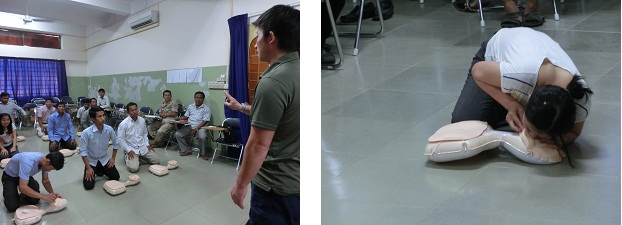
Cardiopulmonary resuscitation (left and right)

Childbirth assistance (left and right)
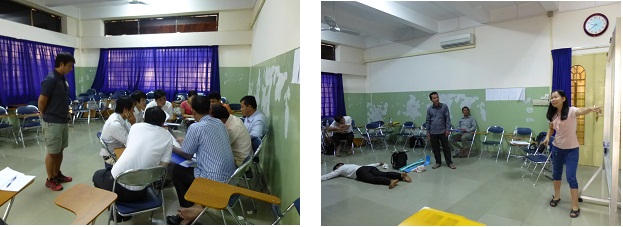
Creation of the teaching outline and evaluation form (left and right)
3rd Workshop Held
From January 21 to 25, workshops were held in Phnom Penh with the objective of passing on knowledge and skills relevant to the safe usage of emergency vehicles. Taking part in the training were staff from national hospitals within Phnom Penh, and drivers/assistants from regional hospitals equipped with emergency vehicles.
On the first day of the workshop, as a first step in learning the basics of safe driving, participants learned about 'risk prediction' while looking at instructional photographs. By accurately predicting possible dangers that can occur in various traffic conditions, the training helped to reduce the possibility of traffic accidents during emergency call-outs. Next, the trainee drivers studied vehicle awareness. In particular, they learned about the range of the blind spot by looking outside the vehicle while seated in the driver's seat.
From the second day, training began on the essentials of emergency vehicle use. In a private area, the participants learned about basic vehicle operation, covering changing direction, crank use, S-turns, and parallel parking.
On the final day, participants drove around the streets of Phnom Penh as part of their applied driving training. This provided them with practice in taking into account the surroundings while driving, by experiencing different road conditions, course changes, traffic intersections, pedestrians and other incoming traffic, as well as predicting possible dangers.
As was the case with the first workshop (September) and the second (December), this workshop was conducted with the cooperation of Khmer-Soviet Friendship Hospital. Taking part as advisors from Japan were Yuki Nakayama, lecturer in emergency systems research at the graduate department of Kokushikan University and Takashi Yonekura, lecturer at the International medical and welfare college, Ichinoseki school emergency department.
As there are none of the driving schools that one finds in Japan and elsewhere in Cambodia, there are few opportunities to learn driving skills. It is no exaggeration to say that this third workshop has been the sole opportunity for people to learn how to drive emergency vehicles safely in Cambodia. As there is little recognition among emergency vehicle drivers in Cambodia that they are actually transporting people requiring treatment, it is necessary to increase the level of recognition of this as well as to improve their driving skills.
| Implementing Agency |
The Sasakawa Peace Foundation
Secretariat of the National Counter Terrorism Committee
|
Year |
Implementation year(1/3) |
| Project Type |
Self OperatedGrantCommissionedOther |
Year project budget implementation |
9,004,744yen |













